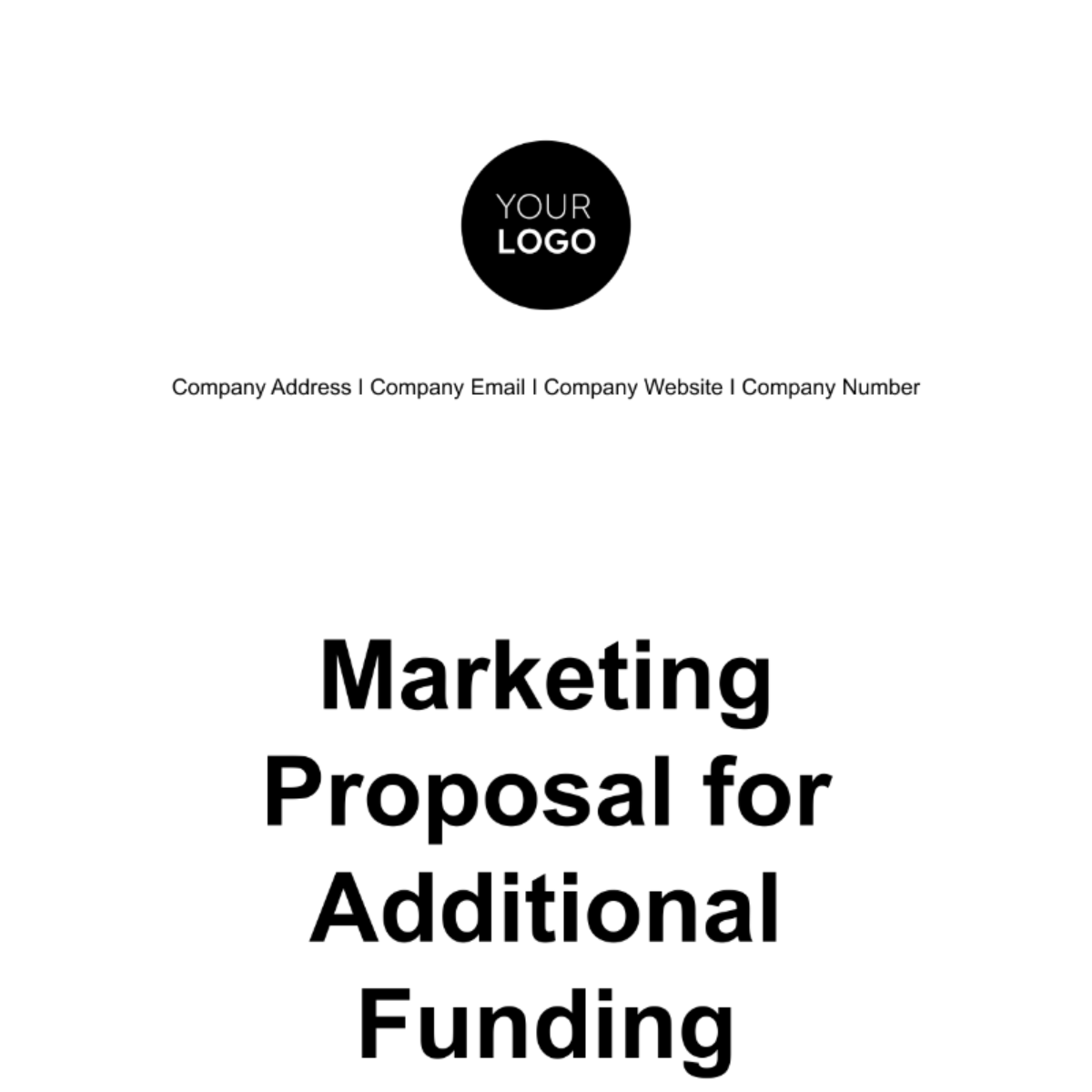Free Marketing SEO Proposal Based on Data Template
Marketing SEO Proposal Based on Data
Executive Summary
In response to the growing demand for online visibility and market share expansion, this proposal outlines a comprehensive SEO strategy for enhancing the digital presence of our client's product, [Product Name]. The proposal is grounded in data-driven insights to optimize website performance, increase organic traffic, and boost conversion rates.
Objectives
1. Increase Organic Traffic
In this phase, our primary focus is on implementing a targeted SEO strategy designed to significantly elevate organic traffic to the [Product Name] website. Through meticulous keyword research, content optimization, and technical SEO enhancements, we aim to attract a broader audience by ensuring that we prominently feature our client's product in relevant search engine results.
2. Improve Keyword Ranking
Our approach involves meticulous analysis, identifying opportunities for improvement. By optimizing on-page content, incorporating high-potential keywords, and continuously refining our strategy based on competitor analysis, we strive to elevate the website's ranking on major search engines, thereby enhancing its visibility to potential customers.
3. Enhance User Experience
We dedicate the core of our strategy to creating an immersive and seamless user experience on the [Product Name] website. Through a combination of technical SEO enhancements, such as improved website speed and mobile responsiveness, coupled with a strategic content marketing plan, we aim to captivate and engage visitors, leading to increased time spent on the site and higher conversion rates.
4. Social Media Integration
Leveraging the power of social media platforms, our goal is to establish a strong online presence for [Product Name]. By developing a comprehensive social media strategy, creating shareable content, and actively engaging with the target audience, we seek to foster brand loyalty, generate buzz, and drive traffic from diverse online channels, complementing our SEO efforts.
Current Website Analysis
1. Traffic Analysis
A. Monthly Website Visitors: Currently, the [Product Name] website attracts an average of [00,000] monthly visitors. This data serves as a baseline for our traffic analysis, allowing us to measure the effectiveness of our SEO efforts over time. Through continuous monitoring and strategic adjustments, our objective is to incrementally increase this figure, reaching a target of [00,000] monthly visitors within the first six months of implementation.
B. Bounce Rate: The current bounce rate on the [Product Name] website is [00]%, indicating that nearly half of the visitors leave the site after viewing only one page. Our analysis will delve deeper into the reasons behind this bounce rate, identifying potential friction points in user experience. By implementing targeted changes in site navigation, content presentation, and calls-to-action, we aim to reduce the bounce rate to [00]% within the first three months, enhancing user engagement and increasing the likelihood of conversion.
C. Source of Traffic: Our analysis reveals that the majority of traffic comes from organic search (00%), followed by direct visits (00%), social media (00%), and referral sources (0%). This breakdown provides valuable insights into the effectiveness of our current digital marketing channels. To capitalize on this data, our strategy will focus on strengthening organic search through SEO optimization, leveraging social media platforms to a greater extent, and exploring partnerships for increased referral traffic. The goal is to achieve a more balanced distribution, with each channel contributing significantly to overall website traffic.
2. Keyword Ranking
A. Current Ranking for Relevant Keywords: Presently, the [Product Name] website ranks within the top 10 search results. However, our analysis indicates that there is room for improvement, particularly for long-tail keywords related to specific flavors and occasions. By implementing a targeted keyword optimization strategy, we aim to elevate the ranking for these long-tail keywords and secure a spot within the top 5 search results, ensuring greater visibility and attracting a more niche audience.
B. Competitor Analysis: In comparison to major competitors in [Product Name] currently lags in specific keyword rankings. Our SEO strategy will involve a robust competitor analysis to identify their successful keyword tactics. By learning from their strengths and leveraging data-driven insights, we aim to surpass competitors in these specific keyword rankings within the next four months, solidifying our position as a leader in [industry].
C. Keyword Research and Optimization: Through extensive keyword research, we have identified high-potential keywords with substantial search volume and relevance to [Product Name]. Our optimization plan involves strategically incorporating these keywords into website content, product descriptions, and meta tags. By ensuring a seamless integration of these keywords, our goal is to achieve a [0]% increase in overall keyword ranking within the first quarter of implementation, propelling [Product Name] to the forefront of online search results for [market/audience].
3. Content Analysis
A. Content Quality: The current analysis of the [Product Name] website content reveals a commendable level of quality, with engaging product descriptions, visually appealing images, and informative blog posts. However, our examination has identified an opportunity to further enhance content quality by incorporating interactive elements. By elevating the multimedia experience, we aim to increase user engagement and time spent on the site, with a targeted goal of achieving a [0]% improvement in overall content quality scores within the next three months.
B. Content Gaps: Despite the existing wealth of content, our analysis identifies specific content gaps that we could address to better serve the needs and interests of the target audience. For instance, there is an opportunity to create content around seasonal promotions. Our content strategy will include a comprehensive plan to fill these gaps, to launch at least two new pieces of content per week. By addressing these content gaps, we anticipate a [00]% increase in organic traffic stemming from content-related searches over the next six months.
C. Blog Section Enhancement: The blog section currently features informative posts. However, our analysis indicates that we can improve the frequency of updates to maintain audience engagement. To address this, our strategy involves increasing blog post frequency to three times per week, covering trending topics in the confectionery industry, user-generated content, and behind-the-scenes glimpses into [Product Name]'s production process. Through this enhancement, we aim to double the blog section's contribution to overall organic traffic within the next quarter.
SEO Strategy
1. Keyword Optimization
Our approach to keyword optimization involves a meticulous strategy to identify and integrate high-impact keywords seamlessly across the [Product Name]website. Through comprehensive keyword research, we have identified key phrases that resonate with our target audience and align with the brand's messaging. We will strategically incorporate the keywords we selected into product descriptions, meta tags, and other on-page elements to enhance the website's relevance to search engines. By executing this strategy, we aim to achieve a [00]% increase in organic traffic stemming from targeted keyword searches within the first two months of implementation.
2. Technical SEO
In the realm of technical SEO, our focus is on ensuring the [Product Name] website is not only visually appealing but also structurally sound for optimal search engine performance. Through an exhaustive website audit, we have identified areas for improvement, including resolving crawl errors, optimizing site speed, and ensuring mobile responsiveness. By implementing these technical enhancements, our goal is to achieve a [00]% reduction in page load times and enhance overall site accessibility. Additionally, the incorporation of structured data markup will be a priority to enhance search engine understanding and potentially secure rich snippets in search results. These technical SEO measures are pivotal for improving user experience and, ultimately, contributing to higher search engine rankings.
3. Content Marketing
Our content marketing strategy for [Product Name] is designed to create a compelling narrative that resonates with our audience, driving brand loyalty and organic traffic. Through the development of shareable and valuable content, including blog posts, social media updates, and multimedia elements, we aim to position [[Product Name] as an authority in the [industry]. The content calendar will include diverse topics such as flavor profiles, seasonal promotions, and behind-the-scenes looks. By fostering engagement and encouraging social sharing, we anticipate a [00]% increase in organic traffic and a [00]% growth in social media followers within the first six months.
4. Backlink-Building:
The backlink-building strategy for [Product Name] focuses on establishing a robust online presence through high-quality, authoritative backlinks. Leveraging data-driven insights, we will identify and reach out to relevant websites, influencers, and industry publications for potential collaborations and backlink opportunities. By securing backlinks from reputable sources within the confectionery and lifestyle domains, we aim to enhance the website's credibility and authority in the eyes of search engines. The goal is to acquire a minimum of [00] quality backlinks within the next four months, contributing to a significant improvement in the website's search engine rankings and overall visibility.
5. Social Media Integration
Our social media integration strategy is a key element in elevating the online presence of [Product Name] and fostering a strong connection with our target audience. Through a comprehensive plan, we will optimize social media platforms, including Instagram, Facebook, and Twitter, to showcase the delightful world of [industry]. The strategy involves regular posting of visually appealing content, such as vibrant images and engaging videos, highlighting product features, seasonal promotions, and customer testimonials. Additionally, we will incorporate interactive elements like polls, giveaways, and user-generated content campaigns to enhance audience engagement. By aligning our social media content with broader marketing themes and leveraging popular industry hashtags, we aim to increase brand awareness and drive traffic to the [Product Name] website. Through this integrated social media approach, we anticipate a [00]% growth in social media engagement and a direct correlation with a [00]% increase in website visits from social platforms within the first quarter.
Implementation Timeline
Conduct Initial Website Audit (Month 0-0): The initial phase of our timeline involves a thorough examination of the [Product Name] website through a comprehensive audit. This process will identify existing technical issues, content gaps, and areas for improvement. The data gathered during this audit will serve as the foundation for subsequent strategic initiatives, ensuring a solid understanding of the current state of the website and providing a baseline for performance measurement.
Keyword Research and Optimization (Months 0-0): With insights from the website audit, the next phase focuses on keyword research and optimization. We will identify high-potential keywords aligned with [Product Name]'s offerings and customer search behaviors. Through meticulous optimization of on-page content and strategic integration of these keywords, we aim to improve the website's search engine visibility and organic traffic. Our goal is to achieve a [0]% increase in keyword rankings within the first quarter, setting the stage for sustained growth.
Technical SEO Implementation (Month 0-0): Building upon the findings of the website audit, we dedicate the fourth month to implementing technical SEO improvements. This includes resolving crawl errors, optimizing site speed, and ensuring mobile responsiveness. By addressing these technical aspects, we aim to enhance user experience, reduce bounce rates, and lay the groundwork for improved search engine rankings. We anticipate a [0]% improvement in overall technical SEO metrics by the end of the implementation month.
Content Marketing Rollout (Months 0-0): The content marketing phase involves the execution of a carefully crafted plan to enhance the website's content quality and relevance. This includes the creation and promotion of engaging blog posts, multimedia content, and social media updates. Through consistent content updates and strategic distribution, we aim to increase user engagement and organic traffic. The goal is to achieve a [00]% increase in website visits attributable to content marketing efforts within the first six months.
Backlink Building (Months 0-0): During the seventh and eighth months, the focus shifts to backlink building. Through targeted outreach and collaboration efforts, we aim to secure quality backlinks from reputable sources within the confectionery and related industries. This approach will enhance the website's authority in the eyes of search engines and contribute to improved rankings. The goal is to acquire a minimum of [00] high-quality backlinks by the end of the eighth month.
Social Media Integration (Months 0-0): We dedicate the final phase of our timeline to the comprehensive integration of social media into the marketing strategy. Through regular and engaging content updates on platforms such as Instagram, Facebook, and Twitter, we aim to increase brand awareness, foster audience engagement, and drive traffic to the [Product Name] website. The goal is to achieve a [00]% growth in social media engagement and a direct correlation with a [00]% increase in website visits from social platforms by the end of the tenth month. We will make regular monitoring and adjustments to ensure optimal performance and sustained growth beyond the proposed timeline.
Monitoring and Reporting
1. Key Performance Indicators (KPIs) and Reporting
Monthly Reports on Website Traffic, Keyword Rankings, and User Engagement: To measure the effectiveness of our SEO and marketing efforts, we will provide comprehensive monthly reports. These reports will include data on website traffic, detailing the number of visitors, page views, and the sources of traffic. We will track and analyze keyword rankings to assess progress, identifying areas of improvement and success. Additionally, user engagement metrics, such as time spent on the site and bounce rates, will be monitored to gauge the impact of content and design changes. The goal is to achieve a consistent month-over-month improvement in these KPIs, showcasing the positive outcomes of our strategic initiatives.
Regular Meetings to Discuss Performance and Adjust Strategy: Beyond static reports, we recognize the importance of dynamic discussions to refine and optimize our strategies. We will hold monthly meetings to review the performance metrics, discuss emerging trends, and identify new opportunities. Through collaborative sessions, we aim to adapt our approach based on the data-driven insights gleaned from the reports. These meetings will serve as a platform to address challenges, celebrate successes, and collectively fine-tune our SEO and marketing strategies to align with the evolving needs of the market and our target audience.

















































